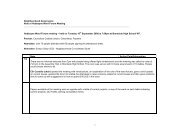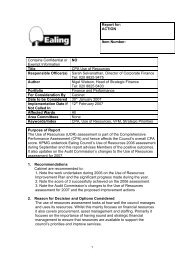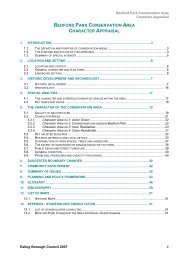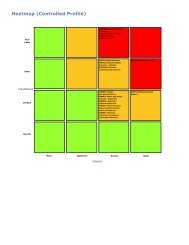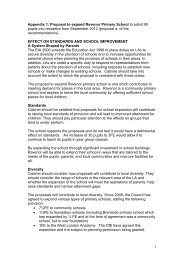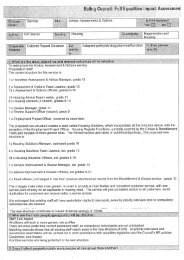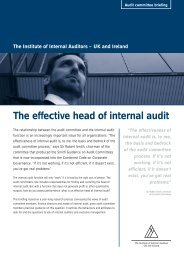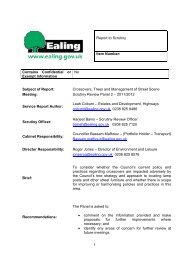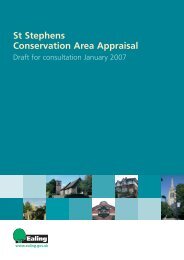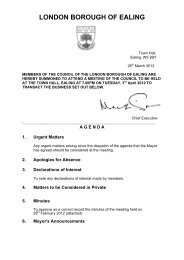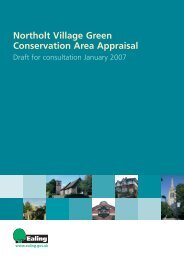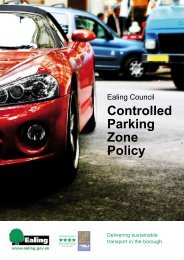St Marks and Canal Conservation Area Appraisal - Ealing Council
St Marks and Canal Conservation Area Appraisal - Ealing Council
St Marks and Canal Conservation Area Appraisal - Ealing Council
- No tags were found...
Create successful ePaper yourself
Turn your PDF publications into a flip-book with our unique Google optimized e-Paper software.
<strong>St</strong>. Mark’s <strong>and</strong> <strong>Canal</strong> <strong>Conservation</strong> <strong>Area</strong>Character <strong>Appraisal</strong>The Enclosure Act of 1814 was another event that greatlycontributed to the change of character of the area. TheAct put an end to the old method of strip-farming <strong>and</strong> theresulting increase in l<strong>and</strong> values encouraged morefarmers to give up their smallholdings on the slope <strong>and</strong>move further south.Larger l<strong>and</strong>owners were gaining control over most of thel<strong>and</strong> to grow hay to meet the ever-increasing dem<strong>and</strong>from London. Rows of terraces were built along UxbridgeRoad <strong>and</strong> around it <strong>and</strong> farmers were forced to seekwork elsewhere.But it was with the coming of the railways in the mid-19 thcentury, first the GWR at Hanwell <strong>St</strong>ation (1839) followedby the Southall to Brentford line (1859), that VictorianHanwell begun to engulf the villages <strong>and</strong> commons ofthis part of the Middlesex.In the 19 th century the northern part of the CA wasoriginally exploited for gravel extraction. Boston Place, infact, was once a gravel pit. Later in 1903, the <strong>Council</strong>bought <strong>and</strong> laid it out for the use of the children growingup in the newly developed “Olde Hanwell”. The Dolphinpublic house <strong>and</strong> a few of the dwellings around the smallgreen - Laurel Bank Villas <strong>and</strong> Frederick Villas - areVictorian but the Factory Yard area towards UxbridgeRoad was earlier <strong>and</strong> densely populated. A well knownactivity in the Factory Yard was a glove factory run by aJohn Fownes, recorded there since1795. The cottage atNo 11a was a Cart House. While Cottages at no 5-11 inBoston Place are early Victorian.The Parish of Hanwell in 1800Westminster Road on the north-easternmost end of theCA used to be the road chosen by middle-classprofessionals for their homes. Mid-Victorianprofessionals, in fact, found this road a convenient placeto set up residence. Always along Westminster Road, theschool of Non-Conformist Union Church of 1867 is now<strong>St</strong> Mary Assyrian Church.From 1870s onwards the l<strong>and</strong> between Lower BostonRoad <strong>and</strong> the canal was laid out in a rectangular streetpattern <strong>and</strong> the development of housing in the southernpart of the CA <strong>and</strong> along Green Lane for the growingpopulation commenced in earnest.Enclosure Map of 1837<strong>Ealing</strong> Borough <strong>Council</strong> 2006 11



